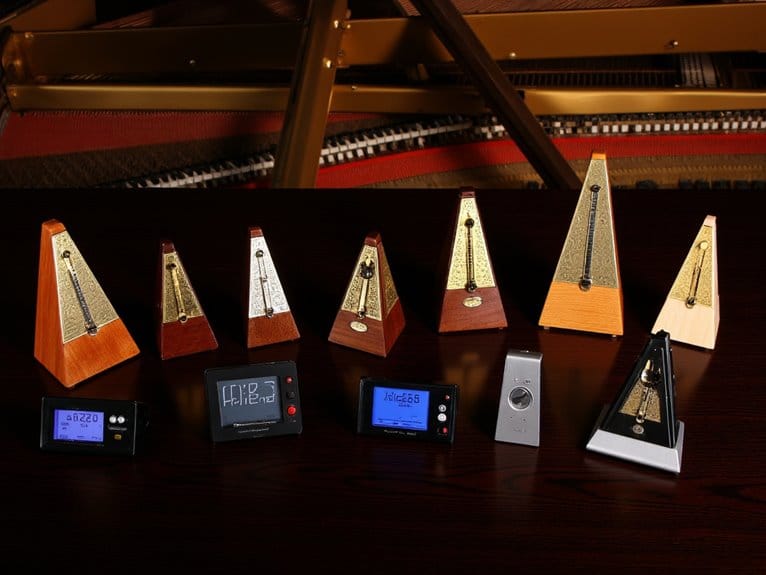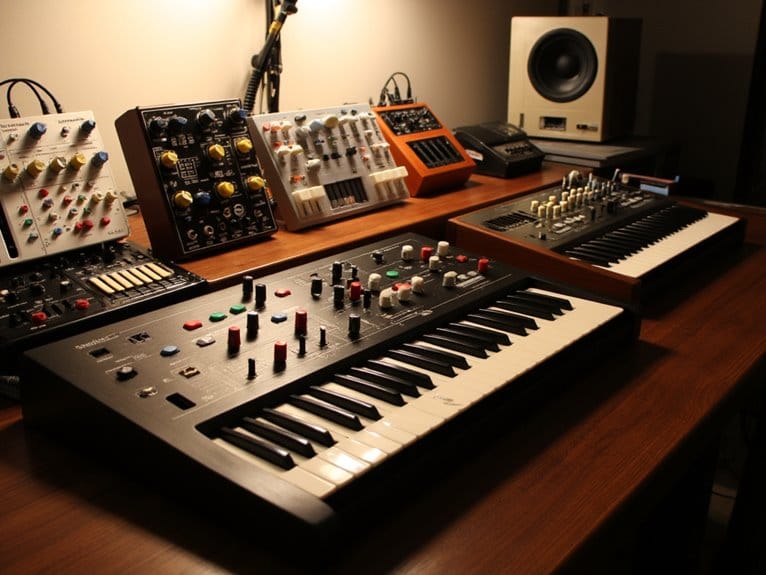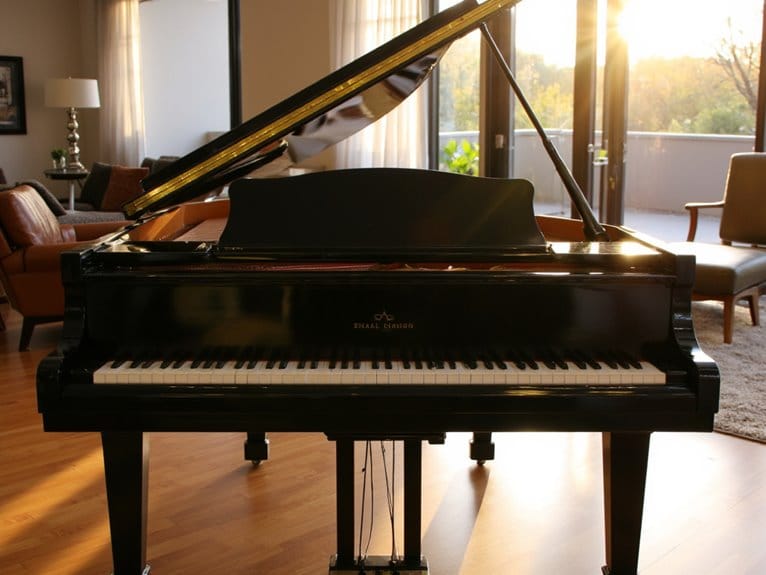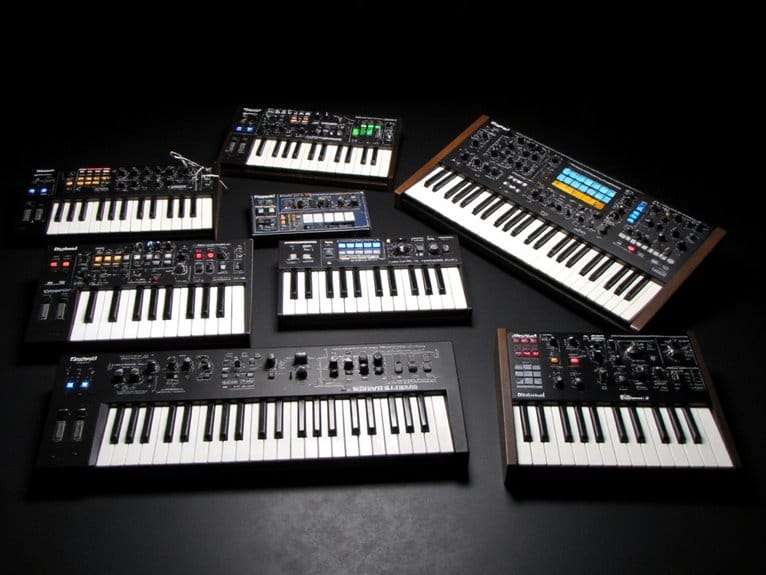10 Best Desk Synthesizers That Will Transform Your Home Studio
I’ve tested dozens of desktop synthesizers, and the standout models include the Behringer 2600 GRAY MEANIE for authentic analog warmth, Roland JU-06A’s portable 128-patch versatility, and MOOG Minitaur’s legendary bass growl. The Hydrasynth offers advanced digital polyphony with wave morphing, while Behringer’s Crave provides exceptional sequencer value for beginners. Voice count, connectivity options, and sound engine type—analog versus digital—determine which synthesizer transforms your studio setup, though understanding specific features reveals the perfect match for your production needs.
We are supported by our audience. When you purchase through links on our site, we may earn an affiliate commission, at no extra cost for you. Learn more.
Notable Insights
- Analog engines like Behringer 2600 GRAY MEANIE and MOOG Minitaur provide warm, rich tones essential for electronic music production.
- Voice count polyphony determines chord complexity, with Roland SH-4d offering 60 voices while Behringer UB-Xa D provides 16 voices.
- MIDI and USB connectivity ensure seamless integration with DAWs and external gear for professional home studio workflows.
- Budget-friendly options like Behringer Crave offer exceptional value for beginners without compromising essential synthesis capabilities.
- Hybrid systems combine digital control with analog sound engines, providing maximum flexibility for diverse sound design projects.
Behringer 2600 GRAY MEANIE Semi-Modular Analog Synthesizer
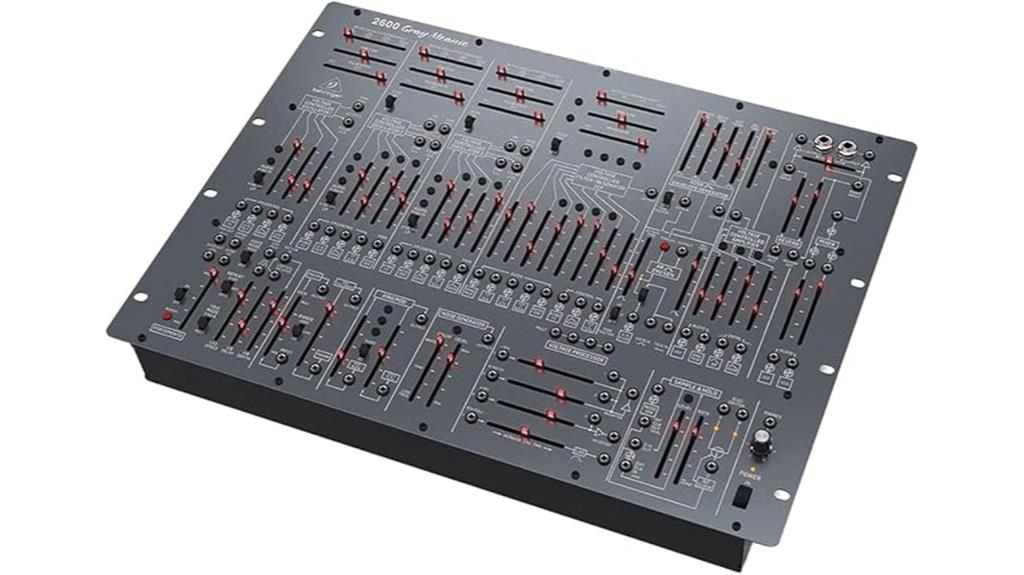
The Behringer 2600 GRAY MEANIE stands as a compelling entry point for producers seeking authentic analog synthesis without the financial burden of vintage gear, offering three voltage-controlled oscillators, multi-mode filtering, and built-in spring reverb in an 8U rack-mountable format that weighs just 2.2 pounds. You’ll find this semi-modular design eliminates patching requirements for basic operation, while each VCO includes LFO functionality, FM inputs, and multiple waveform outputs for creative sound design. The multi-mode filter provides dedicated low-pass output alongside switched high and notch options, faithfully reproducing the ultra-rare ARP Grey Meanie‘s circuitry from the 1970s using carefully selected opamps and transistors for authentic analog character.
Best For: Producers and synthesizer enthusiasts who want authentic analog synthesis and semi-modular functionality at an affordable price point without the expense of vintage equipment.
Pros:
- Triple VCO design with LFO modes, FM inputs, and multiple waveform outputs provides extensive sound creation possibilities
- Authentic reproduction of 1970s ARP Grey Meanie circuitry with carefully selected components delivers genuine analog character
- Semi-modular architecture requires no patching for basic operation while allowing creative expansion with additional cables
Cons:
- Inadequate shipping packaging frequently results in damaged components and bent sliders upon delivery
- Some units arrive with defects, particularly malfunctioning LED indicators requiring quality control inspection
- Limited built-in patch cables may restrict creative potential without purchasing additional connecting cables
Roland JU-06A Sound Module with 8 Patches + 8 Banks
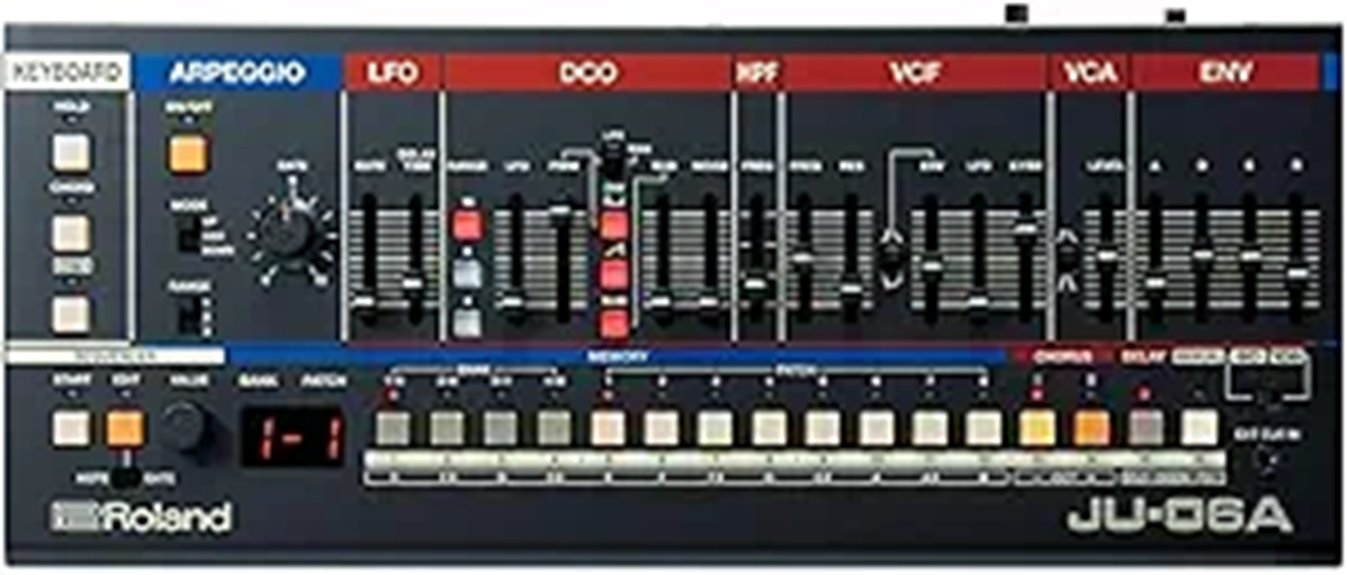
Vintage synthesizer enthusiasts and budget-conscious producers seeking authentic 1980s JUNO tones will find the Roland JU-06A Sound Module delivers remarkable value, combining the warm, deeper character of the JUNO-106 with the punchy attitude of the JUNO-60 in a compact, battery-powered package that weighs just two pounds. You’ll appreciate the 128 total patches across dual synthesizer modes, though I’ll admit the six-hour battery life feels limiting during extended sessions. The adjustable chorus effect maintains impressive sound quality, while the 16-step sequencer and arpeggiator expand creative possibilities beyond the original hardware, making this module particularly effective for recreating classic synth-pop textures.
Best For: Vintage synthesizer enthusiasts, budget-conscious producers, and musicians seeking authentic 1980s JUNO tones in a portable, battery-powered module that combines the warm character of the JUNO-106 with the punchy sound of the JUNO-60.
Pros:
- Dual synthesizer modes offering 128 total patches that authentically recreate both JUNO-60 and JUNO-106 sounds with adjustable chorus effects
- Compact and portable design at just 2 pounds with 6-hour battery life, built-in speaker, and full hands-on controls
- Enhanced features including 16-step sequencer, arpeggiator, and velocity sensitivity that weren’t available on original hardware
Cons:
- Limited 6-hour battery life during extended sessions with no included power supply option
- Compatibility issues with certain MIDI devices and lacks some original JUNO features like CC in/out and full voice count
- No USB cable included in package, requiring separate purchase for computer connectivity
MOOG Minitaur Analog Bass Synthesizer Module
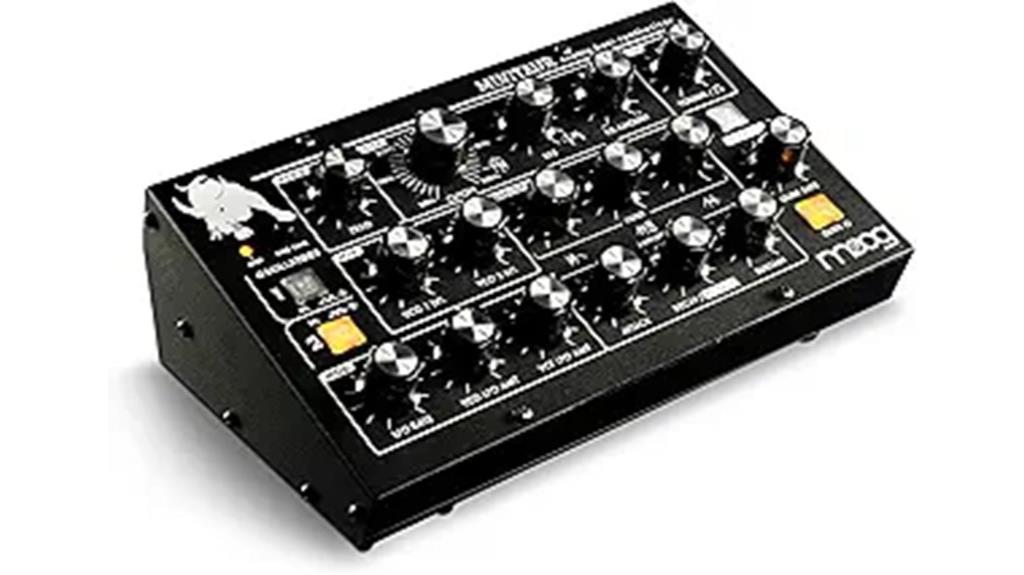
Bass specialists searching for that legendary Moog low-end growl will find their perfect match in the Minitaur, a compact analog powerhouse that delivers nearly five decades of Taurus lineage in a desktop format that won’t dominate your studio space. You’ll appreciate the 100% analog signal path featuring dual VCOs and the iconic Moog Ladder VCF, which generates that deep, punchy low-end that’s made this line famous across genres. The classic one-knob-per-function design keeps tweaking intuitive, while 128 presets provide instant access to professional bass sounds through MIDI and USB connectivity, though some users report occasional software quirks on MacOS systems.
Best For: Bass specialists and electronic music producers seeking authentic Moog analog bass sounds with compact desktop convenience and intuitive hands-on control.
Pros:
- 100% analog signal path with dual VCOs and iconic Moog Ladder VCF delivers legendary deep, punchy bass sounds
- Classic one-knob-per-function design provides intuitive, hands-on control without menu diving
- Compact desktop format with 128 presets and full MIDI/USB connectivity fits easily into any studio setup
Cons:
- Limited sound design capabilities compared to other synthesizers in similar price range
- Software editor has reported stability issues and functionality problems on MacOS systems
- USB connection required for certain features can be unreliable according to user feedback
Hydrasynth Digital Polyphonic Desktop Synthesizer
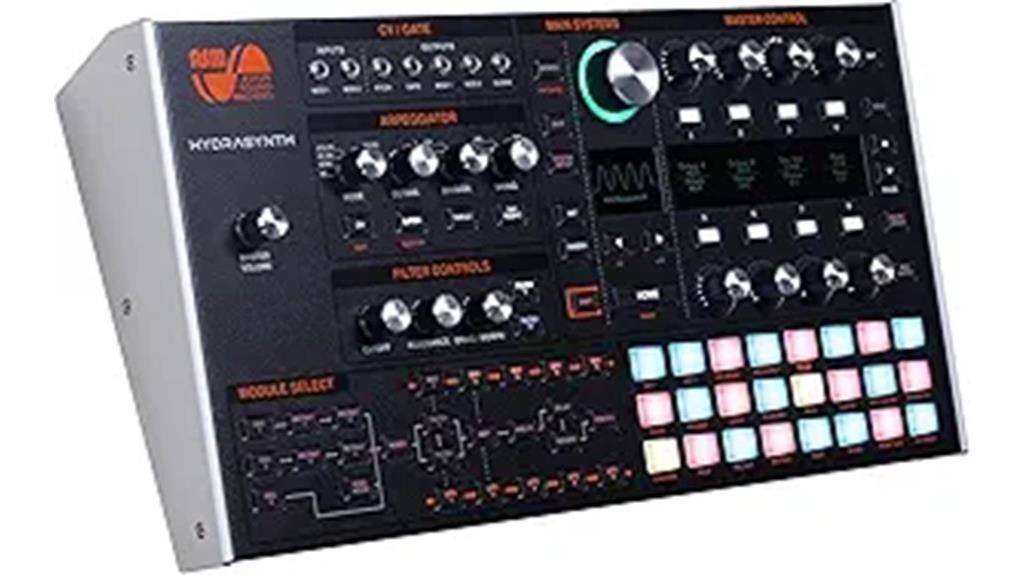
Sound designers and performing musicians who demand maximum creative flexibility will find the ASM Hydrasynth Digital Polyphonic Desktop Synthesizer to be an exceptional choice for their home studio setup. You’ll appreciate the eight-voice polyphonic wave morphing engine, featuring three oscillators with access to 219 single cycle waveforms that deliver remarkable sonic versatility. The unit’s 24 polyphonic pressure touch pads eliminate your need for external controllers, while the intuitive interface enables quick patch editing through workflow shortcuts. With five LFOs, five DAHDSR envelopes, and an extensive modulation matrix offering 32 user-definable routings, you’ll discover endless sound design possibilities that justify its premium position in today’s synthesizer market.
Best For: Sound designers and performing musicians who need maximum creative flexibility and want to create music without external controllers in their home studio setup.
Pros:
- Eight-voice polyphonic wave morphing engine with 219 single cycle waveforms and dual Wave Mutators for exceptional sonic versatility
- 24 polyphonic pressure touch pads eliminate the need for external controllers while providing intuitive music creation capabilities
- Extensive modulation system with 5 LFOs, 5 DAHDSR envelopes, and 32 user-definable routing options in the modulation matrix
Cons:
- Premium pricing may put it out of reach for budget-conscious musicians
- Desktop format lacks built-in keys, requiring external MIDI controllers for traditional keyboard playing
- Complex feature set may have a steep learning curve for beginners new to advanced synthesis
Roland Tweak Synth (S-1)
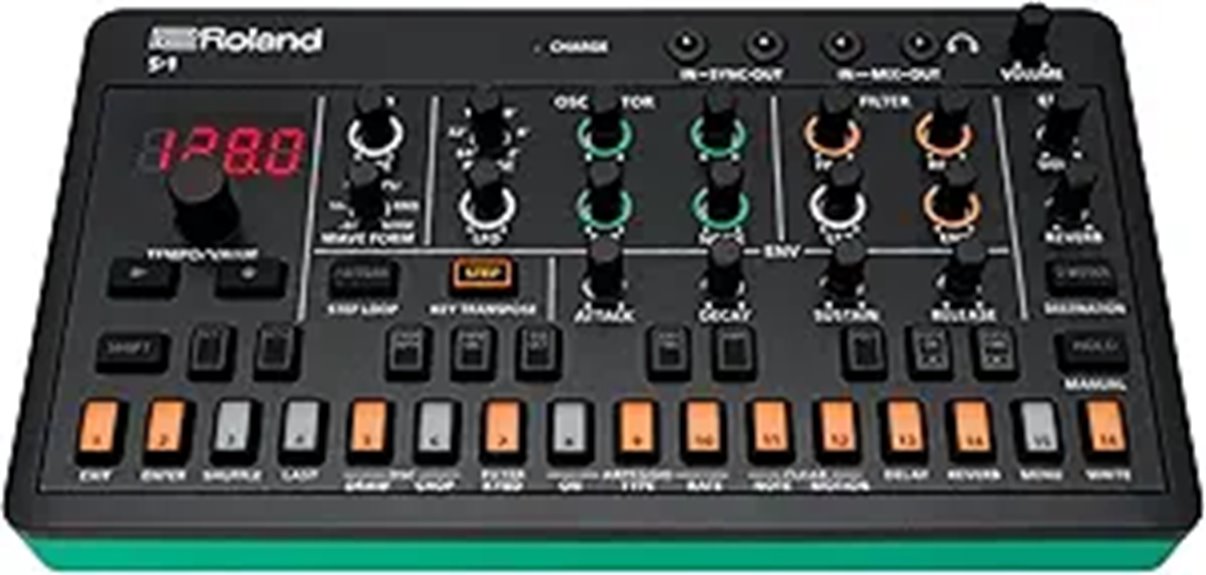
Modern producers seeking the iconic character of Roland’s legendary SH-101 without breaking the bank will find their perfect match in the Roland Tweak Synth (S-1), a micro polysynth that delivers authentic analog flavor through cutting-edge digital modeling. Roland’s Analog Circuit Behavior technology captures that signature SH-101 snap in your basses while maintaining the expressive lead capabilities that made the original a studio staple. You’ll get four-voice polyphony across mono, poly, unison, and chord modes, plus square, sawtooth, sub, and noise oscillators for extensive sound design. The hands-on panel puts immediate control at your fingertips, while onboard sequencing and futuristic wave manipulation tools bring classic analog synthesis into modern production workflows.
Best For: Modern producers and musicians who want the classic Roland SH-101 sound in an affordable, compact package with contemporary features like polyphony and advanced sequencing capabilities.
Pros:
- Authentic SH-101 sound through Roland’s acclaimed Analog Circuit Behavior technology at a fraction of vintage hardware cost
- Versatile four-voice polyphony with multiple modes (mono, poly, unison, chord) expanding creative possibilities beyond the original monophonic SH-101
- Hands-on control panel combined with modern features like onboard sequencing and wave manipulation tools for immediate live performance and studio use
Cons:
- Limited to four-voice polyphony which may be restrictive for complex chord progressions or layered arrangements
- Micro form factor may feel cramped for users who prefer larger, more spacious control layouts
- Being digitally modeled rather than true analog circuitry, it may lack some of the subtle harmonic characteristics and unpredictability that analog purists seek
Roland SH-4d Compact Desktop Synthesizer
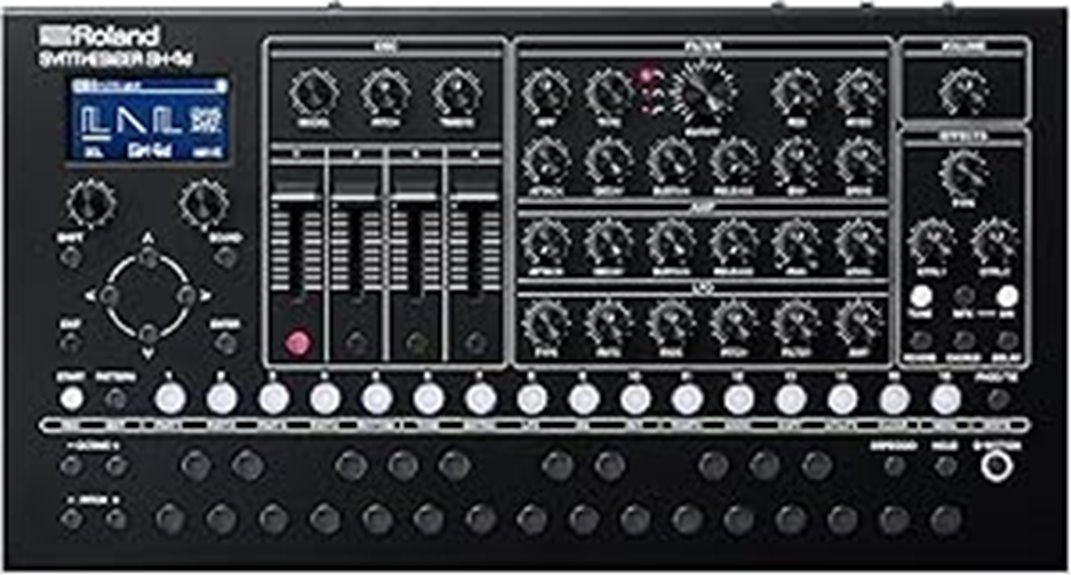
When I first encountered the Roland SH-4d Compact Desktop Synthesizer, I recognized immediately that this powerhouse targets musicians who crave professional-grade versatility without sacrificing precious studio real estate. You’ll discover eleven oscillator models that faithfully recreate classic Roland instruments like the SH-101, JUNO-106, TR-808, and TR-909, delivering authentic analog character through digital convenience. The unit’s sixty-voice polyphony, combined with approximately 1,000 presets and extensive effects processing, transforms your workflow into an intuitive creative experience. While the sequencer’s sixty-four-step limitation and manual saving requirements occasionally frustrate me, the robust metal construction and direct-access controls compensate admirably.
Best For: Musicians seeking a versatile, compact synthesizer that combines classic Roland sounds with modern sequencing capabilities for studio production, live performance, and portable music creation.
Pros:
- Eleven oscillator models faithfully recreate iconic Roland instruments (SH-101, JUNO-106, TR-808, TR-909) with 60-voice polyphony and 1,000 presets
- Robust metal construction with intuitive hands-on workflow featuring 32 knobs, four sliders, and direct-access controls for real-time sound manipulation
- All-in-one functionality combining synthesizer, drum machine, and groovebox with extensive effects processing and USB-C audio/MIDI interface
Cons:
- Sequencer limitations include 64-step maximum per pattern and no song mode, making it better suited for sketching than full compositions
- Convoluted manual saving process without auto-save feature risks losing work if not properly saved
- No sound expansion options or regular updates limit long-term growth potential for users seeking comprehensive functionality
Behringer UB-Xa D 16-voice Analog Synthesizer
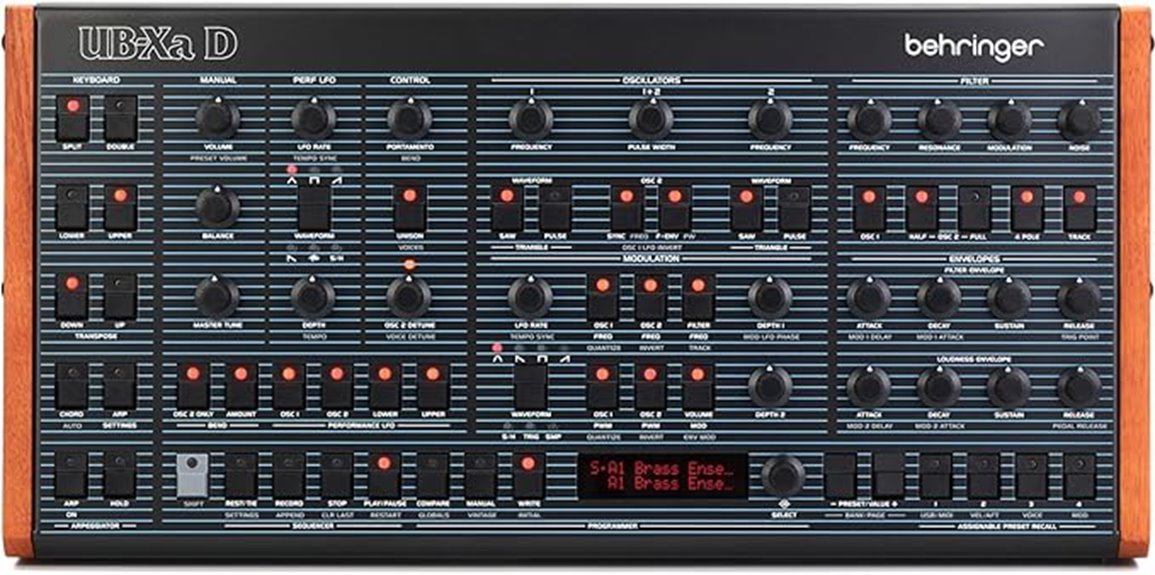
The Behringer UB-Xa D delivers authentic analog warmth through its 32 oscillators and 16-voice polyphony, making it a compelling choice for home studio producers who crave vintage synthesizer character without the vintage price tag. You’ll find eight vintage modes alongside multimode VCF capabilities, plus 512 user preset slots that accommodate extensive sound libraries for multi-timbral compositions. While some users describe the oscillators as “thin” compared to premium alternatives, you’re still getting legitimate analog synthesis with VCA/VCF envelopes and an integrated arpeggiator that enhances creative workflow in your desktop setup.
Best For: Home studio producers and synthesizer enthusiasts seeking authentic analog warmth and vintage character at an affordable price point with extensive polyphony and preset capabilities.
Pros:
- 16-voice polyphony with 32 oscillators provides extensive sound layering and multi-timbral composition capabilities
- 512 user preset slots and 8 vintage modes offer versatile sound design options for various musical styles
- Desktop form factor with integrated arpeggiator delivers professional analog synthesis without the premium vintage price tag
Cons:
- Oscillators described as “thin” sounding compared to higher-end alternatives like the Pro 800
- Limited customer feedback with only 3.5/5 star rating from minimal reviews raises questions about long-term reliability
- 13.6-pound weight makes it less portable than other desktop synthesizers in its class
Behringer Crave Analog Synthesizer with Sequencer
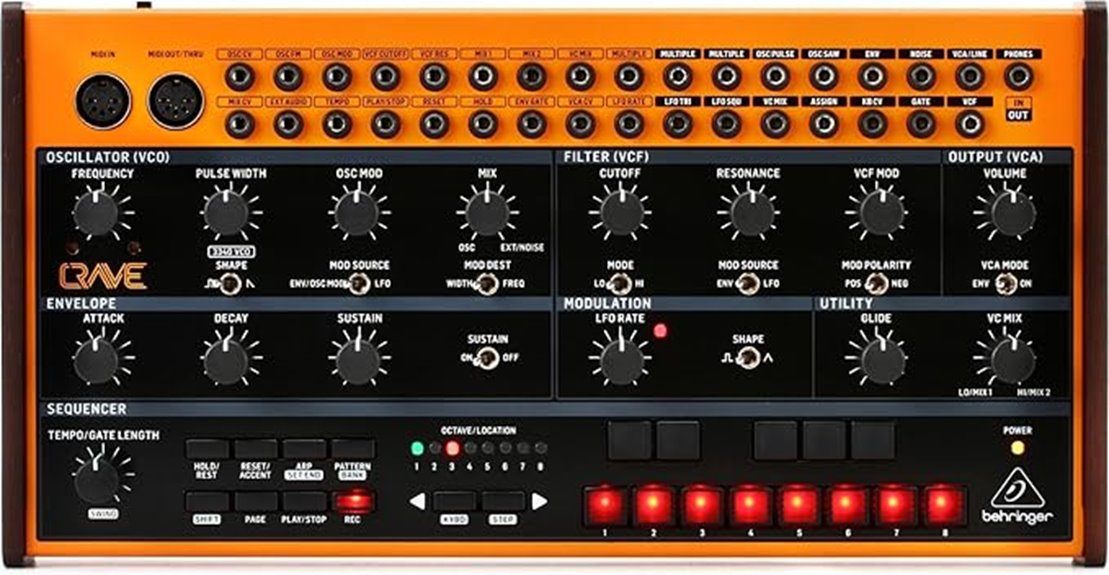
For producers seeking professional analog synthesis without the premium price tag, the Behringer Crave delivers semi-modular capabilities that rival synthesizers costing three times as much. This dark-sounding powerhouse features an 18×14 patch matrix, classic ladder filter, and 3340 VCO that’ll make you forget you’re using budget gear. The 32-step sequencer handles complex patterns flawlessly, while the semi-modular design encourages experimentation with patch cables—though you’ll definitely need to study the manual first. At $199, it’s an exceptional entry point into analog synthesis, offering solid metal construction and seamless MIDI integration that punches well above its weight class.
Best For: Beginners and budget-conscious producers who want to explore analog synthesis and semi-modular capabilities without spending premium prices.
Pros:
- Exceptional value at $199 with solid metal construction and professional sound quality that rivals synthesizers costing three times more
- Versatile semi-modular design with 18×14 patch matrix encourages experimentation and offers unique sound creation possibilities
- Reliable 32-step sequencer with seamless MIDI integration for connecting to keyboards and computers
Cons:
- Minimal included documentation requires studying the manual or online tutorials to fully utilize the synthesizer
- SynthTools software lacks real-time sequencer editing capabilities, requiring notes to be drawn and stored
- Darker tone compared to competitors like Moog Mother 32 may not suit all musical styles or preferences
Behringer Pro VS Mini Hybrid Vector Synthesizer
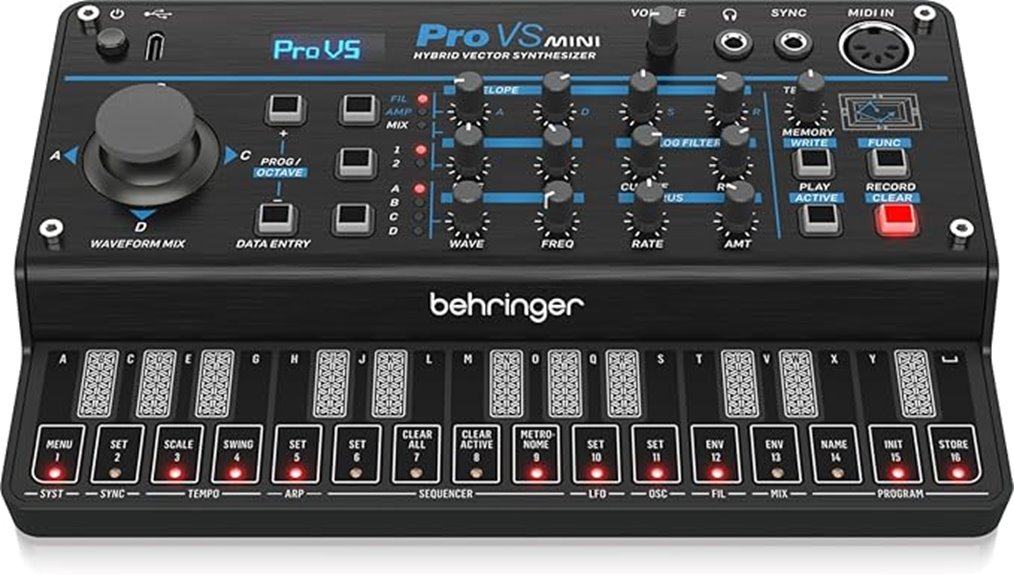
Compact vector synthesis becomes accessible to bedroom producers and synthesizer newcomers through Behringer’s Pro VS Mini, a 4-voice hybrid module that packs 16 vector oscillators, wavetable synthesis capabilities, and an analog low-pass filter into an impressively portable 8.45 x 5.45 x 2.35-inch frame weighing just over a pound. You’ll find the sequencer, arpeggiator, and envelope controls surprisingly intuitive, though I’d recommend pairing it with an external MIDI keyboard since the onboard touch keys feel cramped. The clear screen displays presets and waveforms effectively, making patch navigation straightforward despite being limited to 32 presets.
Best For: Bedroom producers, synthesizer newcomers, and home studio enthusiasts seeking an affordable entry point into vector synthesis and wavetable sound design.
Pros:
- Exceptional value combining 16 vector oscillators, wavetable synthesis, and analog filtering in a compact, portable design under $200
- Intuitive operation with numerous hands-on knobs, clear preset/waveform display, and seamless MIDI keyboard integration
- Impressive sound quality that rivals much more expensive synthesizers, with full-size MIDI DIN connectivity
Cons:
- Limited to only 32 presets when users typically prefer 64-128 for adequate sound storage
- Cramped onboard touch keys make external MIDI keyboard practically necessary for comfortable playing
- USB-only power dependency without battery option limits true portability for mobile music creation
Behringer Model D Analog Synthesizer
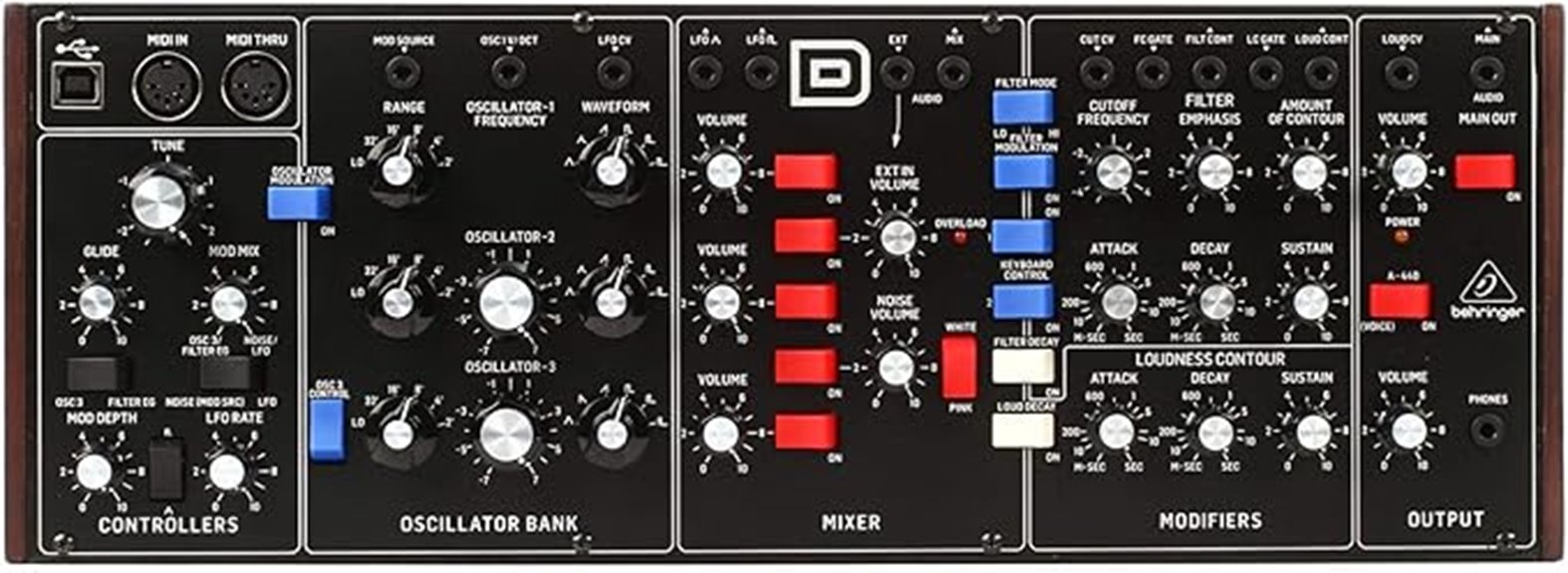
Three oscillators packed into a compact Eurorack-sized module make the Behringer Model D Analog Synthesizer an exceptional choice for home studio producers who want classic Minimoog-style sounds without the vintage price tag or massive footprint. You’ll get that legendary ladder filter alongside dual envelopes, LFO, and thorough MIDI integration that transforms your desktop into a bass-heavy powerhouse. The metal construction feels sturdy despite the affordable pricing, though you might encounter loose knobs occasionally. Users consistently praise its authentic Minimoog character, claiming it’s nearly impossible to distinguish from the original in a mix, making this synthesizer particularly valuable for newcomers learning analog synthesis fundamentals.
Best For: Home studio producers and newcomers to analog synthesis who want authentic Minimoog-style sounds in a compact, affordable package.
Pros:
- Authentic Minimoog sound quality with triple VCOs and legendary ladder filter that’s virtually indistinguishable from the original
- Compact Eurorack-sized design with sturdy metal construction offers classic analog synthesis in a desktop-friendly format
- Excellent value with comprehensive MIDI integration and strong community support for patches and learning
Cons:
- Some units may have loose knobs affecting build quality consistency
- Customer service and warranty support can be difficult to navigate with slow response times
- Limited to monophonic synthesis, restricting chord playing capabilities
Factors to Consider When Choosing a Desksynth
When I’m helping musicians choose their first desktop synthesizer, I always emphasize five essential factors that’ll make or break their studio experience: the sound engine type determines whether you’ll get warm analog tones or crisp digital versatility, while voice count polyphony dictates how many notes you can play simultaneously without cutting off sustained sounds. I’ve seen too many buyers overlook connectivity options and MIDI implementation, which become vital when integrating with DAWs and other gear, though build quality materials and your available budget ultimately shape which models remain realistic contenders. These considerations work together as a framework that’ll guide you toward a synthesizer that matches both your creative goals and practical studio requirements, rather than leaving you with an expensive mistake gathering dust.
Sound Engine Types
Although I’ve tested countless synthesizers over the years, I can tell you that understanding sound engine types remains one of the most essential decisions you’ll make when selecting a desk synthesizer for your home studio. Analog engines, with their voltage-controlled oscillators and filters, deliver that warm, lush character I consistently hear in electronic and pop productions. Digital engines offer broader sonic possibilities through wavetable synthesis and sampling, though they sometimes lack analog’s organic warmth. Hybrid systems combine both technologies, giving you expanded sound design flexibility that I find particularly valuable for diverse projects. Physical modeling synthesizers use mathematical algorithms to simulate acoustic instruments, creating surprisingly realistic traditional sounds. Each type serves different creative needs, so I recommend considering your musical style and production goals when choosing.
Voice Count Polyphony
Beyond choosing the right sound engine, voice count polyphony determines how many notes your synthesizer can play simultaneously, and I’ve learned that this specification profoundly impacts your creative possibilities in ways you might not initially consider. When I’m layering complex chords or creating rich harmonic textures, having sufficient polyphony becomes essential for preventing note dropouts that can interrupt musical flow. I’ve found that 4-voice synthesizers work well for basic leads and bass lines, while 8-16 voices accommodate most contemporary music production needs. Higher polyphony counts, particularly in multitimbral synthesizers, enable simultaneous playback of different patches with unique parameters, allowing me to build elaborate soundscapes and perform sophisticated live arrangements without external sequencing.
Connectivity and MIDI
Since connectivity forms the technical backbone that determines how effectively your desktop synthesizer integrates with your existing gear, I’ve discovered that overlooking these specifications can create frustrating bottlenecks that limit your creative workflow. I always prioritize units offering USB, MIDI In/Out, and dedicated audio outputs, as these connections enable seamless communication with DAWs, keyboards, and external processors. MIDI compatibility remains essential for triggering sounds, synchronizing tempo via MIDI Clock, and expanding your setup’s functionality beyond standalone operation. I’ve found that dual power options—battery and USB—provide invaluable flexibility for both portable sessions and studio integration. Additionally, synthesizers featuring patch bay connections and CV inputs facilitate advanced modulation possibilities, allowing me to craft more complex, unique soundscapes through external hardware routing and creative signal manipulation techniques.
Build Quality Materials
The foundation of any synthesizer’s longevity stems from the materials used in its construction, and I’ve learned through countless studio sessions that build quality directly correlates with both sonic performance and long-term reliability. Metal-bodied units consistently outperform their plastic counterparts in durability, though they’ll weigh considerably more if you’re planning mobile sessions. I’ve noticed that alloy steel chassis designs minimize unwanted resonance and interference, resulting in cleaner audio output during recording sessions. The material choice affects temperature resistance too, which matters more than I initially realized when working in poorly climate-controlled spaces. Solid construction guarantees controls remain responsive over years of use, preventing the frustrating knob wobble and fader drift that plague cheaper plastic alternatives.
Price Range Budget
Most synthesizer purchases fail because musicians underestimate how dramatically price affects both immediate capabilities and long-term satisfaction, and I’ve watched too many producers settle for inadequate gear only to upgrade within months. I recommend establishing your budget first, since desksynths range from $199 entry-level units to $1,000+ professional models, with each tier offering distinct feature sets and sonic capabilities. I analyze features versus cost carefully, comparing oscillator types, filter designs, and modulation options across price brackets to identify the sweet spot for my needs. I also factor in hidden costs like patch cables and software editors, while monitoring seasonal sales that occasionally deliver premium features at mid-range prices through strategic timing.
Physical Size Constraints
After establishing your financial parameters, workspace dimensions become the next limiting factor that’ll determine which synthesizers you can realistically accommodate in your studio setup. I’ve learned that measuring your available desk space before shopping prevents expensive disappointments, especially when considering larger units like the Roland JU-06A at 16.02 x 14.45 x 8.27 inches. Weight matters too—the Behringer 2600 GRAY MEANIE’s 2.2 pounds might seem light, but stability becomes vital during intense playing sessions. I prefer compact options like the Behringer Pro VS at 8.45 x 5.45 x 2.35 inches for maximizing workspace, though rack-mountable units like the ASM Hydrasynth offer vertical solutions when desk real estate runs thin.
On a final note
I’ve walked you through eight exceptional desktop synthesizers that’ll genuinely elevate your home studio setup, from Behringer’s budget-friendly powerhouses to Roland’s polished classics and Moog’s unmistakable analog warmth. Each synth offers distinct sonic characteristics, workflow advantages, and price points that cater to different production needs. Remember to contemplate your musical style, available space, and integration requirements before making your final decision—you can’t really go wrong with any of these selections.


